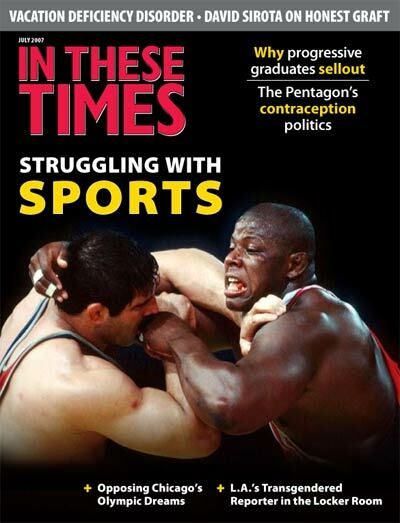He Shoots, She Scores
When Mike became Christine, she gave Los Angeles sports fans a courtside view of gender politics
John Ireland

For all of its trappings of money, fame, and corruption, professional sports has a lot to do with character. Avid sports fans seem to respect those who face up to overwhelming challenge and overcome adversity. So it should not come as a surprise that readers rose in solidarity when a 23-year veteran sports writer announced in the Los Angeles Times that he would return from a short hiatus…as a woman.
On April 26, Mike Penner wrote what he thought would be the toughest article of his career. “I am a transsexual sportswriter. It has taken more than 40 years, a million tears and hundreds of hours of soul-wrenching therapy for me to work up the courage to type those words.” The piece ran in the Sports section, next to his regular column.
According to the Los Angeles Times, Penner’s story was “by mid-evening, one of the most heavily viewed stories on latimes.com in the last year, with about half a million page views.” Nancy Sullivan, executive director of communications for the newspaper, says “There was a massive response to this story, not only on our website, but across the media spectrum.” The online message board accompanying the article was closed to comments in less than 8 hours, with 800 comments logged in. Hundreds more messages were sent via e-mail. Responses to the revelation came in three distinct flavors: kudos from sports fans, effusive thanks from other transsexuals and rants from bible-thumpers. Readers’ initial shock, however, subsided almost immediately.
Michael Daniel Penner returned to work on May 23 as Christine Michelle Daniels. So far, it appears to be smooth sailing. But Daniels’ very public transition has put a spotlight on a culture that is slow to acknowledge, let alone attempt to rehabilitate its ingrained intolerance and bigotry.
Translating her world
“The concept of one day having to come out publicly, as an LA Times sports columnist, was a paralyzing fear that, looking back, kept me from transitioning at least 5 years sooner,” Daniels tells In These Times. She says she was “bracing for the worst.”
Many of Daniels’ colleagues have gone out of their way to champion her cause. “Some sportswriters,” she says, “have written column items of support, some who know me pretty well have spoken to others on my behalf, without my knowledge, delivering the message that, ‘This is just another writer, a normal person, facing a difficult challenge.’”
Sports blogs almost uniformly expressed admiration for her courage and wished her well. Overall, readers seem to be mildly bemused, but focused on her return to work. One commenter summed up the majority consensus: “Yea yea yea and all that girlie stuff, no problema. … But how ‘bout them Angels this weekend? Gonna get back to bizz? Need you back Christine.”
Some response has been negative. It’s difficult to assess where it originates – within the sports community or those drawn by the spectacle. TheAngryT.com, an obscure sports blog, rants, “I am a straight male … Do you care what I look like or whether I wear high cut panties out of the Sears women’s wear catalogue? LA Times readers should no longer look for Mike Penner’s column when they want hard-hitting sports journalism.”
Sportswriters frequently express passion and enthusiasm for their subject, exposing more personality than reporters covering different beats. They often develop loyal followings and become a trusted voice that keeps readers up-to-date. In a world of high ticket prices, the sportswriter functions as the reader’s passport to the field, court or stadium. For Daniels, this connection to her fans, and the known quality of her writing, may have smoothed her transition.
“I just always liked the spark in his writing, his wit and his use of language,” says fellow Southern California journalist Joel Beers. “Penner’s done a lot: covered the Olympics, wrote about media, NFL lead writer. But, after 23 years, it’d seem he’d be a dean of the Times sports section as opposed to just another very good writer in a section that has a lot of them. I always wondered why he seemed to bounce from beat to beat but never got what would seem to me the choicest of assignment: columnist.”
It would seem that Daniels’ bravery has yielded that opportunity twofold. She has two columns: Day in L.A., which the paper describes as “a daily column on the sports events, personalities and themes that matter most to Southern Californians,” and Woman in Progress, a blog on latimes.com in which she chronicles her transformation, comments on the angst that accompanied her public “coming out,” and describes re-connecting with friends and colleagues she had kept at a distance since beginning hormone replacement therapy (HRT) in December.
Her first few weeks of posts indicate that each blog retains its distinct focus. Based on the heavy traffic to both blogs, much of her original audience has stayed on, in order to catch a glimpse of her personal journey. Daniels is making sports history by creating a space where questions of intolerance and bigotry can be posed and, through online comments, discussed.
Daniels knows that the average sports-page reader experiences cognitive dissonance when imagining a man donning a wig, a dress, pumps and lipstick to head out for a day at the mall. In a recent post, she related why many male-to-female “transwomen” are focused on the exterior. “We never had a girlhood. We missed out on all the fun (dolls, sleepovers, mother-daughter outings) and the rites of passage natural-born females take for granted… [It’s] just a normal part of growing up female.”
Her employer’s approach to the situation helped normalize Daniel’s gender-switch. When she revealed to her supervisor, Sports Editor Randy Harvey, that she would be transitioning, he insisted that she write the piece in order to stay in control of the story. Some critics thought that personal narrative belonged in the Op Ed section and not in the Sports section. Others believed she should be fired. One post to a blog sponsored by CBS SportsLine.com put it this way: “When a reporter makes himself the story, which he is clearly doing, he is definitely not serving the interests of his reading public and quite honestly should be fired for these ego-driven actions.”
In the majority of states, being fired would be a distinct possibility. In February, the city of Largo, Fla., fired its city manager of 14 years after he revealed his plans to undergo sex reassignment surgery, also known as SRS. California, however, is one of the eight states (along with Illinois, Maine, Minnesota, New Jersey, New Mexico, Rhode Island and Hawaii, as well as Washington D.C.) that have passed laws that prohibit discrimination based on gender identity. Oregon will join the list on January 1, 2008, and the legislatures of Vermont, Iowa and Colorado have passed bills that await their governors’ signatures.
An unexamined culture
Traditionally, the sports world is quick to minimize and ignore issues of bigotry when they arise and instead “focus on the game.” In so doing, it misses a chance to discuss the issues and identify the underlying symptoms. Some would sweep Daniels’ revelation under the rug in order to maintain the status quo and avoid what might be unsettling self-examination.
U.S. sports history is rife with examples of a pervasive culture of racism, sexism and homophobia. Football commentator Jimmy “The Greek” Snyder was fired by the CBS network in 1988 after describing on the air how African Americans were naturally superior athletes because they had been bred to produce stronger offspring during slavery. The words that got him fired were, “During the slave period, the slave owner would breed his big black with his big woman so that he would have a big black kid – that’s where it all started.”
Although primarily criticized as racist, Don Imus’ April 4 reference to the Rutgers University women’s basketball team as “nappy headed hos” revealed an insidious sexism that has been at the core of the sports world’s resistance to professional female athletes. Just months before, retired NBA player Tim Hardaway was suspended from participating in NBA publicity events after saying on a local radio show: “Well, you know I hate gay people, so I let it be known. I don’t like gay people and I don’t like to be around gay people. I am homophobic. I don’t like it.” Homophobia has persisted like a healed-over injury that acts up when gender roles are challenged.
“That culture is very real,” says Daniels. But she sees her proactive “coming out” and the Woman in Progress blog as an opportunity for fans to examine their discomfort with transsexuals in sports. Her blog holds up a magnifying glass for those who are willing to peer through it.
Daniels is in the process of getting new press credentials from local teams. “I have not ventured into a press box or locker room as Christine yet. But soon,” she said with anticipation. “Most of the publicity directors from the local pro sports teams have contacted me to say, ‘Welcome back, Christine, we look forward to working with you.’”
Transsexuals in sports
Daniels is not the first transsexual to emerge from the sports world. In 2003, Chris Kahrl, sportswriter and founding columnist of the annual Baseball Prospectus, the gold standard for baseball analysis, became Christina. At the time, Kahrl wrote, “nobody has batted an eye,” calling sports “the ultimate American social bridge,” transcending “race, gender, class, and culture.” The history of transsexuals as sports players, however, hasn’t always borne out such triumphant optimism.
In 1972, Richard Raskind reached the final of the men’s national 35-and-over tennis championships. Three years later, he underwent sex-reassignment surgery, becoming Renée Richards. In 1976, the U.S. Tennis Association denied her entrance into the U.S. Open. In 1977, the New York Supreme Court ruled in her favor, allowing her to reach the doubles final at that year’s competition. She went on to coach Martina Navratilova to win two of her 20 Wimbledon championship titles.
For nearly 20 years, women’s golf, which has a significant number of lesbian players and fans, has excluded transsexuals from competition. Two years after transsexual Charlotte Wood placed third in the U.S. Senior Women’s Amateur in 1987, the U.S. Golf Association (USGA) added a “female at birth” clause in its entry forms and many other golf organizations around the world followed suit.
In 2004, however, the Australian Ladies Professional Golf Association (ALPGA) reversed its 1991 “female at birth” decision and allowed Mianne Bagger to join. Bagger, who was born male and had SRS in 1995, was ranked sixth on the national amateur circuit before turning professional in 2004. She currently plays on the ALPGA and Ladies European Tours. Bagger’s success has had an international impact, as well. In 2005, the USGA changed its policy, allowing transgender athletes to compete in the U.S Women’s Open. The same year, the Ladies Golf Union did the same, which allowed Bagger to play in the Women’s British Open.
And in May 2004, the International Olympic Committee published its “Stockholm Consensus,” outlining eligibility for participation in gender-classified competitions. It states that eligibility of transgender athletes to compete should begin no sooner than “two years after gonadectomy,” that “verifiable” hormone therapy has been administered, and that “legal recognition of their assigned sex has been conferred by the appropriate authorities.”
Changing medical consensus
The confusion manifested in the sports world over transsexuality is understandable when one considers the lack of settled opinion in the medical world. Much has changed in the past 50 years and definitive classification is still in flux.
The term “transsexual” entered popular parlance in the ’50s to describe a person who identified and often presented as a member of the opposite gender. In 1980, the American Psychological Association added “Transsexualism” to its Diagnostic and Statistics Manual (DSM-III). In 1994, the group replaced the diagnosis with “Gender Identity Disorder” (DSM-IV). The term “transgender” emerged around the same time to describe those with unusual gender identities without psychopathologizing them as “disordered.” This is considered an umbrella term covering all types of “gender dysphoria,” which literally means being uncomfortable with one’s gender.
Medical professionals have different opinions as to the appropriateness of hormones, surgeries, transition counseling and even conversion therapy, which would seek to reverse the gender dysphoria and reconcile the individual to his or her biological gender. Treatments can cost between $15,000 and $50,000 and are not covered by most U.S. health insurance policies. Many countries that have comprehensive nationalized health care, including Canada and most European countries, do cover the cost of treatment, to varying degrees.
Surgery and legal recognition
Legal recognition of gender change varies around the world. In the United States, only Idaho, Ohio and Tennessee prohibit the change of sex on a birth certificate. Every province in Canada permits this, as do most western European countries. The latter, however, require proof of a diagnosis and HRT, in addition to SRS. Spain requires proof of HRT for two years, but not surgery. Germany will grant the official change of gender only if the person is unmarried, permanently infertile, and has had surgery changing the “outer sexual characteristics.” The United Kingdom requires only that the person prove s/he suffers from gender dysphoria. Japan will grant the legal change, but only if the person is unmarried and childless. Australia is one of the few countries that will issue a new birth certificate, as opposed to amending an existing one.
Thailand has become a haven for inexpensive SRS procedures for transsexuals from around the globe, making it a hotspot for this type of “medical tourism.” Ironically, Thailand does not grant changes in gender in official records for its own citizens.
The small town of Trinidad, Colo., is known as the gender reassignment capital of the United States, due to the work of former Army surgeon Stanley Biber, who specialized in the surgeries in the late ’60s. Before his death in 2006, he estimated that he had performed 5,800 such procedures and trained hundreds of other surgeons. The International Foundation for Gender Education estimates that more than 30,000 Americans have undergone SRS.
Unlike the rest of the Muslim world, Iran sanctions SRS, as it has been valid under Islamic Shariah since Ayatollah Ruhollah Khomeini issued a fatwa in 1983. Since homosexuality is punishable by death, however, it appears that surgery is the only option for many who might otherwise be hanged for being gay. As a result, an unregulated and marginally underground surgical industry has developed, leaving in its wake many post-operative patients who are not technically transsexual.
Life goes on
Discussing her public transition with In These Times, Daniels acknowledges that hard work lies ahead. “The overwhelming warm, positive and supportive response I have received has done much to buoy my spirits and get me emotionally prepared for the next career hurdle: covering sporting events and interviewing athletes and coaches as Christine,” she says. “You know, for more than 20 years now, I have been a woman sportswriter going into locker rooms all the time. Only then, nobody, myself included, realized it.”
Daniels will likely remain an expert in two realms. On her Woman in Progress blog, she will continue to share her own journey and transition from male to female, educating and provoking thousands of casual onlookers, while providing support and comfort to those on a similar journey. In her “Day in L.A.” column, she will remain the first stop on many a fan’s morning read-through of the Sports section, continuing to digest and contextualize the world of sports with her characteristic wit.
In a recent blog entry, Daniels addressed, if indirectly, the many questions people have asked about the extent and timetable of her transition. She wrote, “Gender identity is not about genitals. It is about what’s in your head and in your heart. I am not taking a vacation to have SRS. I am taking a vacation to have a vacation.”
Regardless of what comes her way, Daniels will do what she does best: churn out 2,000-plus words a day that speak to her readers. For reporter and reader alike, there’s not much better than that.








